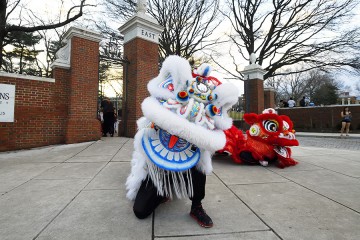When Angie Lao, co-president of Johns Hopkins' Chinese Students Association, first came to the Homewood campus, she knew she wanted to find a community where should could learn about and celebrate her Chinese heritage. After attending her first CSA-sponsored Lunar New Year celebration, she said she knew she found what she was looking for. Now, in her senior year, she hopes to pass that passion on to others.
Sunday night, more than 200 students came out to welcome the Year of the Rat and embrace the cultural traditions behind it at the CSA's annual Lunar New Year Banquet.
Decked out in the traditional red and gold of the holiday, the Glass Pavilion in Levering Hall was transformed into a banquet hall and performance space as students enjoyed a dinner by China Wok and performances by Hopkins' student groups Lan Yun Blue Orchids, KPM, Music Dynasty, and the Yong Han Lion Dance Troupe.
Lao said the Lunar New Year Banquet is one of the key events for the group.
"I think given that a lot of people come from international locations, this is a great reminder of what home is," Lao said. "Lunar New Year is a time to be with family and be with friends. It's a really great time of year, and we want to be able to recreate that special month for people who may not be able to go home."
The Lunar New Year falls on the second new moon after the Dec. 21 winter solstice, occurring annually between Jan. 21 and Feb. 20. Each new year is represented by one of the 12 animals from the Chinese Zodiac; 2020 is the Year of the Rat, representing strong vitality for those born under its sign.
During Sunday night's celebration, officers from the CSA gave a presentation on the mythology behind the Lunar New Year, followed by trivia on the traditions and history of the celebration. Many of the holiday's most popular elements come from the story of the monster Nián, who would come up from the sea once a year to attack a small village. One year, a beggar shared with the villagers the things Nián most feared: the color red, bright lights, and loud noises. Today those things form the traditions of the holiday.
According to Philip Lan, a junior molecular and cellular biology major with the CSA, families place red banners known as spring couplets on all of the doors of their homes, hand out red envelopes to bring good fortune, and light firecrackers in celebration. Though firecrackers were omitted from the campus celebration, the other traditions were well-represented, as the Yong Han Lion Dance troupe sent dancers costumed in traditional lion garb out into the crowd.
While the other traditions provide the backdrop for the New Year celebration, the heart of the holiday is family. For Gavin Li, a senior neuroscience major, the Hopkins celebration is an annual tradition that always reminds him of home. Huiyao Chen, a sophomore public health major, said there's more to the banquet than just a fun night out.
"The Lunar New Year is a really important festival," Chen said. "It's like Christmas. It's like the New Year. This is our chance to come together, have fun, and celebrate our culture and the people that we cherish."
Posted in Student Life
Tagged student life









